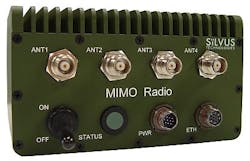Networked radio for controlling several unmanned vehicles introduced by Silvus Technologies
LOS ANGELES, 1 Aug. 2012. Silvus Technologies Inc. in Los Angeles is introducing the SC3800 radio to control unmanned vehicles. The SC3800 provides dual-band operation from 400 MHz to 2.7 GHz and 4 GHz to 6 GHz. The SC3800 is available in a ruggedized IP67 chassis or as a printed circuit board stack for embedded systems installations.
As operational scenarios become increasingly complex, the warfighter needs simple and effective communications solutions that enables him to focus on the mission, Silvus officials say.
The SC3800's network-management graphic user interface (GUI) provides an intuitive way for the operator to evaluate the signal strength and traffic at each point in a mesh network, allowing them to identify and resolve any bottlenecks or weak links. The network management GUI is accessible via the SC3800's web interface using any standard web browser.
The SC3800 uses COFDM modulation and advanced multiple-input and multiple-output (MIMO) antenna processing techniques for range, throughput, and mobility, even in the most challenging environments. The unmanned vehicle control radio operates from pure line-of-sight (LOS) to extreme non-line-of-sight (NLOS).
Silvus radios are for duplex connectivity between two or more radios, forming a self-healing, self-forming mesh network that optimizes itself in response to changing environmental conditions, company officials say.
The Silvus proprietary approach to MIMO provides enhanced spectral efficiency, combining high quality video, and command-and-control data on a single link, and eliminating the need for several radios on an unmanned vehicle.
For more information contact Silvus Technologies online at www.silvustechnologies.com.
Follow Avionics Intelligence news updates on Twitter, and join the revamped Avionics Intelligence group on Linkedin at www.linkedin.com/groups/Avionics-Intelligence.

